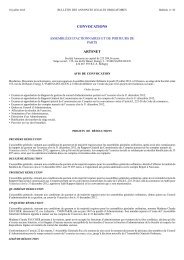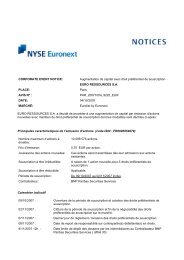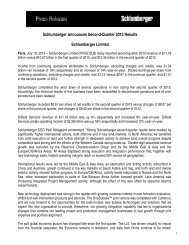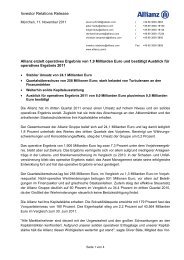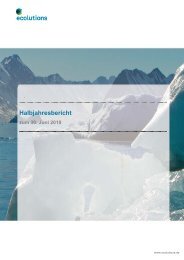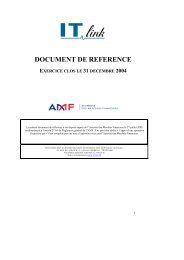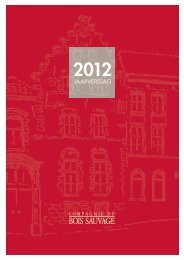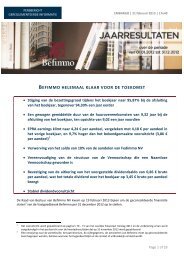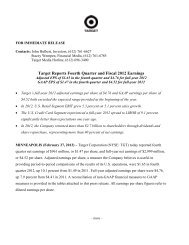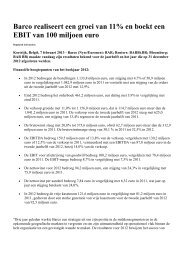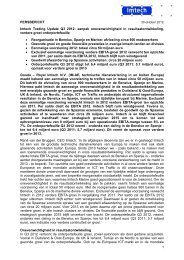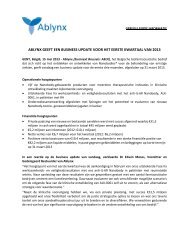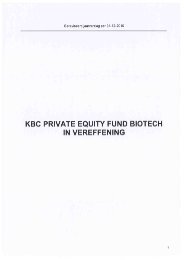FORM 10-Q
FORM 10-Q
FORM 10-Q
You also want an ePaper? Increase the reach of your titles
YUMPU automatically turns print PDFs into web optimized ePapers that Google loves.
inventory practices, the number of selling days in a reporting period, supply point changes, timing of price increases, new product introductions and changes<br />
in product mix can impact unit case volume and concentrate sales volume and can create differences between unit case volume and concentrate sales volume<br />
growth rates. In addition to the items mentioned above, the impact of unit case volume from certain joint ventures in which the Company has an equity<br />
interest, but to which the Company does not sell concentrates or syrups, may give rise to differences between unit case volume and concentrate sales volume<br />
growth rates.<br />
Information about our volume growth worldwide and by operating segment for the three months ended March 29, 2013, is as follows:<br />
Unit Cases 1,2,3<br />
Percent Change<br />
2013 versus 2012<br />
First Quarter<br />
Concentrate<br />
Sales 4<br />
Worldwide 4% 2%<br />
Eurasia & Africa 15% <strong>10</strong>%<br />
Europe — (2)<br />
Latin America 4 2<br />
North America 1 (2)<br />
Pacific 3 4<br />
Bottling Investments (6) N/A<br />
1 Bottling Investments operating segment data reflects unit case volume growth for consolidated bottlers only.<br />
2 Geographic segment data reflects unit case volume growth for all bottlers in the applicable geographic areas, both consolidated and unconsolidated.<br />
3 Unit case volume percent change is based on average daily sales. Unit case volume growth based on average daily sales is computed by comparing the average daily sales in each<br />
of the corresponding periods. Average daily sales are the unit cases sold during the period divided by the number of days in the period.<br />
4 Concentrate sales volume represents the actual amount of concentrates, syrups, beverage bases and powders sold by, or used in finished beverages sold by, the Company to<br />
its bottling partners or other customers and is not based on average daily sales. Each of our interim reporting periods, other than the fourth interim reporting period, ends on<br />
the Friday closest to the last day of the corresponding quarterly calendar period. As a result, the first quarter of 2013 had two fewer days when compared to the first quarter<br />
of 2012, and the fourth quarter of 2013 will have one additional day compared to the fourth quarter of 2012. In addition, due to 2012 being a leap year, our full year 2013<br />
results will have one less day compared to full year 2012.<br />
Unit Case Volume<br />
Although a significant portion of our Company's revenues is not based directly on unit case volume, we believe unit case volume is a measure of the<br />
underlying strength of the Coca-Cola system because it measures trends at the consumer level.<br />
Three Months Ended March 29, 2013, versus Three Months Ended March 30, 2012<br />
In Eurasia and Africa, unit case volume increased 15 percent, which consisted of 12 percent growth in sparkling beverages and 26 percent growth in still<br />
beverages. The group's sparkling beverage growth was led by 12 percent growth in brand Coca-Cola, <strong>10</strong> percent growth in Trademark Fanta and 15 percent<br />
growth in Trademark Sprite. Growth in still beverages was primarily due to juices and juice drinks and included a 15 percentage point benefit attributable to<br />
acquired volume, primarily related to our Aujan partnership. Russia reported unit case volume growth of 8 percent, which included growth of 15 percent in<br />
both brand Coca-Cola and Trademark Fanta as well as growth of 7 percent in Trademark Sprite. Still beverage growth in Russia included growth of 13<br />
percent and 27 percent in our juice brands Dobriy and Rich, respectively. Unit case volume growth in Russia was favorably impacted by the beginning of<br />
marketing activities related to the Sochi 2014 Winter Olympics and Torch Relay. Eurasia and Africa also benefited from unit case volume growth of 30 percent<br />
in the Company's Middle East and North Africa business unit, including a 13 percentage point benefit attributable to acquired volume, primarily related to our<br />
Aujan partnership.<br />
Unit case volume in Europe was even, despite poor weather, especially in March, competitive pricing and ongoing weakness in consumer confidence and<br />
spending across the region. Sparkling beverage growth in Europe was positive during the quarter, but rounded to even, and still beverages declined 3 percent.<br />
Germany reported unit case volume growth of 3 percent, driven by strong integrated marketing campaigns, solid execution in the marketplace and customer<br />
distribution gains. Europe also benefited from 4 percent unit case volume growth in Great Britain, led by growth in sparkling beverages, including growth of<br />
3 percent in brand Coca-Cola. The favorable impact of growth in Germany and Great Britain was offset by volume declines in<br />
29



